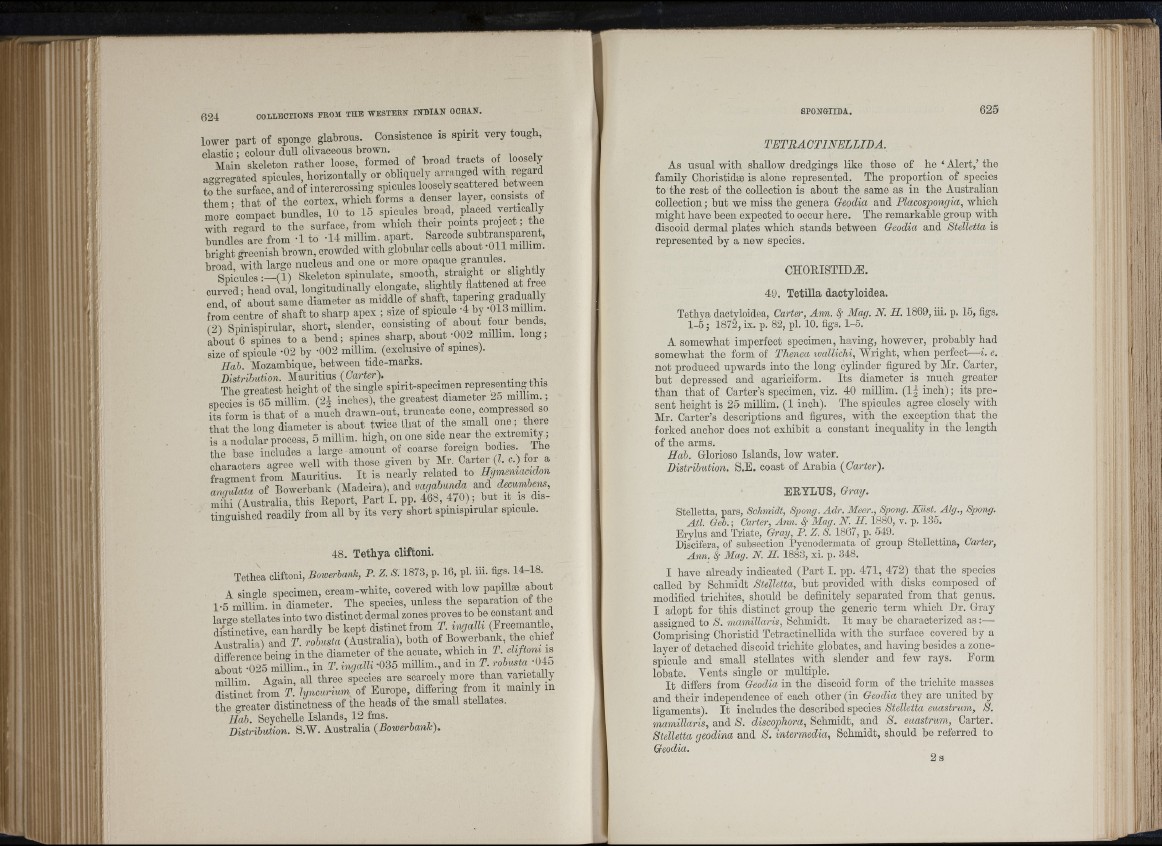
] I |i. luç
I j '
t liH
Mil:
L
il
C O L L E C T I O N S E R O M T H E W E S T E R N I N D I A N O C E A N .
lower part of sponge glabrous. Consistence is spirit very tougb,
obistie • colour dull olivaceous brown.
Maié skeleton ratber loose, formed of broad tracts of loosely
acTgregated spicules, borizontally or obliquely a /a n g e d witb regard
to tbe surface, aud of intercrossing spicules loosely scattered hetwe.
tbem ; tb at of tbe cortex, wbicb forms a denser layer, consists of
more compact bundles, 10 to 15 spicules broad,
witb regard to tbe surface, from wbicb tbeir points project, tbe
bundles are from 4 to 4 4 millim. apart. Sarcode siibtransparent,
bright greenish brown, crowded witb globular cells about -Oil millim.
broad with large nucleus and one or more opaque granules.
Spicules (1) Skeleton spinulate, smooth, straight or slightly
curved; head oval, longitudinally elongate, slightly flattened at free
end of about same diameter as middle of shaft, tapering gTadually
from centre of sbaft to sharp apex ; size of spicule 4 by -013 milbm.
(2) Spinispirular, short, slender, consisting of absout four bends,
about 6 spines to a bend; spines sharp, about -002 miUim. long,
size of spicule -02 by -002 millim. (exclusive of spines).
Hah. Mozambique, between tide-marks.
Distrihution. Mauritius {Carter). _
Tbe greatest beigbt of tbe single spirit-specimen representing this
species is 65 mülim, (2 i inches), the greatest diameter 25 mih™ ;
ite form is tb a t of a mucb drawn-out, truncate cone,
th at tbe long diameter is about twice tb at of tbe small one ; there
is a nodular process, 5 millim. high, on one side near the extremity
tbe base includes a large amount of coarse foreign bodies. The
characters agree well with those given by Mr. Carter (Z. c.) for a
fra-rment from Mauritius. I t is nearly related to HymeniacMon
n-nmilata of Bowerbank (Madeira), and vagahunda and decumbens, Sf(lastraba, tbis Beport, Part I. pp 468, 470)_; but it, is distinguished
readily from all by its very short spmispirular spicule.
48. Tethya cliftoni.
TetMa cliftoni, Boioerhanh, P. Z. S. 1873, p. 16, pi. iii. figs. 14-18.
A single specimen, cream-white, covered witb low papillæ about
1-5 millim. in diameter. Tbe species, unless tbe separation of the
lar<re stellates into two distinct dermal zones proves to be constant and
distinctive, can bardly be kept distinct from T .m g a lh (Freemantle
Australia) and T. robusta (Australia), both of Bowerbank, the chief
difference being in tbe diameter of tbe acuate, which in T. cliftoni is
i o u t -025 miUim., in T. ingalli '035 millim and in T rohusta -04o
millim Again, aU three species are scarcely more than v a rie ta l/
distinct from T. lyncurium of Europe, differing from it mainly in
tbe greater distinctness of tbe beads of tbe small steUates.
Hah. SeycbeUe Islands, 12 fms.
Distrihution. S.W. Australia {Bowerhank).
S P O N G I I D A .
TE T R A C T IN E L L ID A .
As usual with shaUow dredgings like those of be ‘ A lert,’ tbe
family Choristidæ is alone represented. Tbe proportion of species
to the rest of the coUection is about tbe same as in tbe Australian
coUection ; but we miss tbe genera Geodia and Placospongia, wbicb
might bave been expected to occur here. Tbe remarkable group witb
discoid dermal plates which stands between Geodia and Stelletta is
represented by a new species.
CHOBISTIDÆ.
49. Tetüla dactyloidea.
Tetbya dactyloidea, Carte)-, Ann. ^ May. N. H, 1869, iii. p. 15, figs.
1-5 ; 1872, ix. p. 82, pi. 10. figs. 1-5.
A somewhat imperfect specimen, having, however, probably bad
somewhat the form of Thenea wallichi, Wright, when perfect—Z. e.
not produced upwards into tbe long cylinder figured by Mr. Carter,
but depressed and agariciform. Its diameter is much greater
than that of Carter’s specimen, viz. 40 miUim. ( 1 | inch); its present
beigbt is 25 millim. (1 inch). Tbe spicules agree closely witb
Mr. Carter’s descriptions and figures, with tbo exception tb a t the
forked anchor does not exhibit a constant inequaUty in the length
of the arms.
Hah. Glorioso Islands, low water.
Distrihution. S.E. coast of Arabia (Garter).
ERYLUS, Gray.
Stelletta, pars, Schmidt, Spong. Adr. Meer., Spong. Käst. Alg., Spong.
Atl. Geb.-, Carter, Ann. 8f Mag. N. H. 1880, v. p. 135.
Erylus and Triate, Gray, P. Z. S. 1867, p. 549.
Discifera, of subsection Pycnodermata of group Stellettina, Carter,
Ann. ^ Mag. N. H. 1883, xi. p. 348.
I bave already indicated (P a rt I. pp. 471, 472) tb a t the species
caUed by Schmidt Stelletta, but provided with disks composed of
modified trichites, should be definitely separated from th at genus.
I adopt for tbis distinct group tbe generic term wbicb Dr. Gray
assigned to S . mamillaris, Schmidt. I t may be characterized as :—
Comprising Cboristid Tetractinellida with tbe surface covered by a
layer of detached discoid trichite globates, and having besides a zone-
spicule and small steUates with slender and few rays. Form
lobate. Vents single or multiple.
I t differs from Geodia in tbe discoid form of tbe trichite masses
and tbeir independence of each otber (in Geodia tbey are united by
ligaments). I t includes tbe described species Stelletta euastrum, 8.
mamillaris, and S. discophora, Schmidt, and S . euastrum, Carter.
Stelletta geodina and S. intermedia, Schmidt, should be referred to
Geodia.
II
t '-
I'
6 ÎI J
7 ÎL